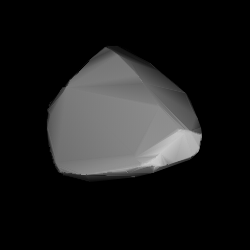Related Research Articles

Ophelia is a large, dark Themistian asteroid that was discovered by French astronomer Alphonse Borrelly on 13 January 1877, and named after Ophelia in Shakespeare's Hamlet.

Thusnelda is a typical S-type Main belt asteroid. It was discovered by Johann Palisa on September 30, 1880, in Pola and was named after Thusnelda, wife of Germanic warrior Arminius.

343 Ostara is a background asteroid from the inner region of the asteroid belt. It was discovered by German astronomer Max Wolf at the Heidelberg Observatory on 15 November 1892.

Ottilia is a large main-belt asteroid. It was discovered by Max Wolf on March 16, 1895, in Heidelberg. It is named after the Germanic folkloric character Ottilia.
Mathesis is a main-belt asteroid that was discovered by German astronomer Friedrich Karl Arnold Schwassmann on March 28, 1900. Its provisional name was 1900 FC.
Bruchsalia is a main-belt asteroid. It was discovered by Max Wolf and Friedrich Karl Arnold Schwassmann on May 22, 1900. Its provisional name was 1900 FG.
Signe, provisional designation 1900 FM, is a stony asteroid from the background population of the intermediate asteroid belt, approximately 26 kilometers in diameter. It was discovered by German astronomer Max Wolf at Heidelberg-Königstuhl State Observatory on 22 October 1900. The asteroid was presumably named after Signy, a character of the Scandinavian Völsunga saga and Norse mythology. Signy is the daughter of Völsung and sister of Sigmund.

Laura is Main-belt asteroid discovered on 9 January 1901 by Max Wolf at Heidelberg. The semi-major axis of the orbit of 467 Laura lies just inside the 7/3 Kirkwood gap, located at 2.95 AU. It's named after the character Laura from Amilcare Ponchielli's opera La Gioconda.
Tokio is a main-belt asteroid discovered on 2 December 1902 by Auguste Charlois at the Nice Observatory. Attribution to Astronomer Shin Hirayama of the Azabu Observatory, Tokyo, Japan for the 1900 discovery and naming of Tokio as cited in the 1947 Monthly Newsletter of the Royal Astronomical Society Vol 107, page 45.
Ada is a minor planet orbiting the Sun. It was discovered January 29, 1904, by American astronomer Raymond S. Dugan at Heidelberg, Germany and was named after his friend Ada Helme. CCD images collected during the fall of 2004 at Oakley Observatory in Terre Haute, Indiana, were used to generate a lightcurve for the object, showing a rotation period of 10.03 ± 0.01 hours.

Nassovia is a minor planet orbiting the Sun. It is a member of the Koronis family of asteroids.
Deborah is a minor planet orbiting the Sun. It was discovered by Max Wolf on August 4, 1904. The semi-major axis of the orbit lies just inside the 5/2 Kirkwood gap, located at 2.824 AU. It was named after the biblical character Deborah.

662 Newtonia is a minor planet, specifically an asteroid orbiting mostly in the asteroid belt.
678 Fredegundis is a minor planet orbiting the Sun. It was discovered 22 January 1909 from Heidelberg by German astronomer K. Wilhelm Lorenz, and was named after the French opera Frédégonde. This object is orbiting at a distance of 2.57 AU with a period of 4.13 years and an eccentricity (ovalness) of 0.22. The orbital plane is inclined at an angle of 6.1° to the plane of the ecliptic
727 Nipponia is a minor planet orbiting the Sun. It is a member of the Maria family of asteroids.
768 Struveana is a minor planet orbiting the Sun. The asteroid was named jointly in honor of Baltic German astronomers Friedrich Georg Wilhelm von Struve, Otto Wilhelm von Struve and Karl Hermann Struve.
883 Matterania is an S-type asteroid belonging to the Flora family in the Main Belt. Its rotation period is 5.64 hours
903 Nealley is a minor planet orbiting the Sun. The semi-major axis of the orbit of 903 Nealley lies just inside the Hecuba gap, located at 3.27 AU.
975 Perseverantia is a minor planet orbiting the Sun that was discovered by Austrian astronomer Johann Palisa on 27 March 1922.
3361 Orpheus is an Apollo asteroid that was discovered on 24 April 1982 by Carlos Torres at Cerro El Roble Astronomical Station. Its eccentric orbit crosses that of Mars and Earth, and approaches Venus as well. From 1900 to 2100 it passes closer than 30 Gm to Venus 11, Earth 33, and Mars 14 times. It passed by Earth at a distance of about 0.03 AU in 1937, 1978, 1982, and 2021 and will again in 2025.
References
- ↑ "463 Lola (1900 FS)". JPL Small-Body Database . NASA/Jet Propulsion Laboratory . Retrieved 10 May 2016.